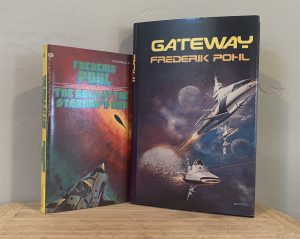[expanded 24jun20 5pm]
I need to catch up on book notes. I’m not a fast reader, and am busy with other things throughout the week, reading perhaps 3 hours a day at best, but still get through about 2 books a week. I think I’ll try to condense my comments to just the essential points, rather than post lengthy annotated plot summaries. (Taking notes on books is easy; condensing them into useful précis is more difficult, but much more useful.)

I still have to put each book in context. Moreso than you might think, context is everything. Frederik Pohl was a magazine and anthology editor, and a writer of novels and short fiction, in the 1950s and 1960s, with works like The Space Merchants (a 1950s satire of the advertising industry, written with C.M. Kornbluth) and “Day Million” (a dazzling 1966 short story about the future social mores of a couple in love that Pohl anticipates his contemporary readers will find shocking). Good, occasionally great, yet intermittent work. In the early 1970s though he rebooted himself into a steady, major writer, of both novels — about one a year, for the next two decades — and short fiction. (I think I read that Pohl had had a near-death experience in the early 1970s that led him to re-evaluate his life, and shift his priorities back to writing fiction.) His first novel of this period was Man Plus, in 1976, which won a Nebula; the second was Gateway, in 1977, and it won the Hugo, Nebula, Campbell, and Locus awards — the four major awards of that time. It remains a popular, well-regarded novel; I believe it’s Canadian SF author Robert J. Sawyer’s favorite SF novel of all time.
(My Facebook comment after Pohl’s death in 2013 is posted on this blog here: http://www.markrkelly.com/Blog/2013/09/03/frederik-pohl/.)
This book is easier to summarize than to describe chapter by chapter.
- The broad story is about the discovery of an asteroid full of spacecraft built by aliens called the Heechee, perhaps millions of years ago, and abandoned, with no trace of the Heechee or where they went. Humans find the asteroid, called Gateway, via the discovery of one of the individual spacecraft on Venus. The individual spacecrafts pilot themselves, and travel faster than light to various points in the galaxy, in entirely unpredictable ways. So, volunteers go out on prospecting expeditions hoping to find Heechee artifacts, or anything else interesting (such as artifacts that can be exploited for wealth on Earth), on the planets they come to, which would result in lifetime riches. But there’s a risk: some 15% never come back, and others come back with their crews dead.
- The main character is Robinette Broadhead, who grew up with his parents mining shale oil in Wyoming; in this future Earth, such shale is turned into food for a hungry, overcrowded world.
- The frame story is some 16 years after RB left Gateway. RB got rich, somehow, and now lives in a domed New York City, and is in therapy with a cybernetic psychiatrist called Sigfrid von Shrink, and seems concerned about some incident with a woman on Gateway named Klara.
- The recounted main story (in flashbacks) is how RB won a lottery to get passage to Gateway, how he hemmed and hawed about signing on to these dangerous expeditions, about his first couple expeditions, and about the payoff expedition that rewarded him and made him wealthy but involved tragedy—which is why later he went into therapy.
- And there are sidebar diagrams or infodumps, interspersed in the narrative, e.g. with rules about living in Gateway, with classified ads placed by prospectors on Gateway, and so on. These each fill a page, in the nontraditional style of some ‘60s mainstream writers. In the second half of the book these include excerpts from lectures to prospectors about various phenomena: neutron stars, black holes, etc. On p245, a conspiracy theory about the number 13.
So, the book is a bit New Wavish, even resembling Silverberg’s DYING INSIDE, in its nonlinear structure, in its attention to the psychology of its protagonist, and in its collage of narrative with sidebar artefacts.
I should at least summarize the plot arc, and (spoiler) its conclusion which, as the best conclusions do, explains everything that we’ve read before and provides an emotional payoff.
- Chapters alternate sessions with Sigfrid von Shrink, with the back story of Robinette Broadhead’s coming to Gateway, his hesitation about signing up for the available missions, in the various Heechee ships that hold 1 person, 3 people, or 5 people. (This is a brilliant suspense strategy; we know something profound and troubling happened to RB, but we don’t get to know what, until the very end.)
- RB’s payoff mission involves sending two Heechee ships, with five people each, to the same destination, a few minutes apart, to see what happens.
- But as it happens, the two ships arrive near a black hole, too near; they risk getting sucked in to its event horizon. The six people on the two ships stage an escape strategy, by spinning the two ships around a common link so that one can escape by being flung outside the event horizon.
- It doesn’t go as planned; RB is left in the one ship that escapes, the other five — including his lover Klara — are stuck in the other.
- RB returns to Gateway. He’s distraught, but is given a huge bonus for the information gleaned from this mission. Thus his later residency in NYC.
- And so back in the present frame story, Sigfrid von Shrink helps him to understand what’s happened. The five in the other ship sunk into the black hole, but because of time dilation as they approached the speed of light… they are, in a sense, still alive right now, in RB’s experience.
- RB’s problem is that he can’t live like this, knowing that Klara is still alive in some sense, but doomed to die, but that he is still living.
- And in some poignant final lines, the cybernetic Sigfrid von Shrink reminds RB that he *is* still living, in a way SvS can only envy.
The principal science-fictional appeal of the novel is the mystery of the aliens, where they went, why they left ships behind and why they “cleaned up” a lot of them, and what they were like in any way. This book was so well-received that Pohl wrote several sequels, albeit with diminishing returns, that explored these mysteries.
Here’s a passage, page 224, describing some of the Heechee tools:
There were about ten little prayer fans, proving, I guess, that the Heechee liked to include a few art objects even with a tire-repair kit. Or whatever the rest of it was: things like triangle-bladed screwdrivers with flexible shafts, things like socket wrenches, but made of some soft material; things like electrical test probes, and things like nothing you ever saw before. Spread out item by item they seemed pretty random, but the way they fit into each other, and into the flat nested boxes that made up the set, was a marvel of packing economy.
(I’m reminded of that passage in Clarke’s Childhood’s End, quoted here, http://www.markrkelly.com/Blog/2014/06/06/clarke-childhoods-end-part-2-themes/, about a human, in alien custody, shown human artifacts that he cannot identify.)
And on page 230, how Heechee metal glows.
Other comments:
- The book depicts very casual attitudes, in this future era, about sex and drug use (marijuana). The book written in 1977. Gays are matter of fact. And bisexuals. One of the large-crew expeditions includes a permanent three-way gay relationship. Yet a bit weirdly, toward the end we learn some of RB’s fantasies (about a male passenger) are related to his mother having taken his temperature, as a child, up his butt. This strikes me as way off the mark about the nature of sexuality.
- Page 253.4: Discussion of boys’ stories, Tom Sawyer and Lost Race of Mars. The latter was an early (and very incidental) juvenile novel by Robert Silverberg; was this mention a tip of the hat to Pohl’s fellow writer and editor?
- P297 is a sidebar about Heechee nutrition: there’s a reference to possible food factories in the outer cometary belts. As I recall, this was one of the ideas Pohl followed up upon in the sequels: Beyond the Blue Event Horizon (1980), Heechee Rendezvous (1984), The Annals of the Heechee (1987), The Gateway Trip (1990), and The Boy Who Would Live Forever (2004).
A significant prologue to this novel was Pohl’s 1972 novella “The Merchants of Venus.” It was collected, later in 1972, in the Ballantine collection The Gold at the Starbow’s End (its title story another major Pohl work of the era), and I will summarize the stories in that book in my next post.





